Lab-to-Lab: US-Russian Lab-to-Lab Collaboration Story [Archived]
Milton Levenson | Cheryl Rofer
Cheryl Rofer worked as a chemist and manager in several divisions at Los Alamos from 1965 through 2001. Her work ranged from laser isotope separation to development of environmental cleanup technologies and canning plutonium from decommissioned nuclear weapons. Her management of environmental cleanups led to her work with the Estonians on Sillamäe.
Averting a Baltic Sea Disaster
Cheryl Rofer, LANL (retired)
Read it in PDF
In 1992, I was given a brochure by a Los Alamos manager about a production plant for rare earth metals and oxides in Estonia. The plant was called Silmet, and it was in a town called Sillamäe, about twenty kilometers west of the Russian border, on the Gulf of Finland, an arm of the Baltic Sea. The brochure, in Russian and English, also mentioned a “waste depository.” None of us could figure out what that “waste depository” was.
There were many other questions about about the Silmet plant. Some DOE reports identified it as a possible uranium enrichment site. Another guess was that it was a production facility for plutonium parts for nuclear weapons. Sillamäe had been closed to Estonians during Soviet times.
Operations at the site began in 1946. Russian workers were brought in to staff the plant. Occasionally, warnings were published prohibiting swimming and fishing along the Estonian north coast. Something was being done there that could pollute the water.
The manager suggested I write a proposal to help in the cleanup that was mentioned in the brochure. I wrote a proposal, and it was forwarded on. Nothing happened. I kept the brochure and the proposal in my file.
______
In late 1997, another Los Alamos manager attended a meeting in Vilnius, Lithuania. There he met Tõnis Kaasik, who had been Estonia’s Minister of the Environment just after the Soviet Union broke up and was CEO of a government-private partnership, Ökosil Ltd., charged with cleaning up the Sillamäe site. When he returned, the manager checked a Lab database for people who might know something about Estonia and found two names. My five-year-old proposal made me the expert.
NATO was encouraging the Lab to host its Advanced Research Workshops with countries that had been part of the Soviet Union. I wrote up a couple of paragraphs proposing a workshop on Sillamäe. Estonia was not as wired as it is now, and emails were erratic. We faxed the proposal with a cover letter to Kaasik just before Christmas break. When we returned on January 5, 1998, the pile of incoming faxes held an invitation to attend a meeting of the Sillamäe International Expert Reference Group on January 21.
The decision that I was to go was quickly made, and the Occupational Medicine group took over: immunizations for polio, hepatitis, and typhoid fever. Shots every few days, shots in both arms. Even so, I didn’t complete the series for hepatitis, which required a six-week interval between shots. Probably good enough; don’t drink the water. The Lab’s counterintelligence team briefed me. They didn’t know much about Estonia, so they talked about Russia.
_____
January 17 I overnighted in Denver, on the way to Tallinn via Chicago and Frankfurt. I barely knew that name when the ticket machine spit out a baggage tag with TLL on it. In dark and rainy Frankfurt, I began to have second thoughts. I groggily surveyed the dozen other people waiting for the flight: a mafia-looking man, a woman with hennaed hair, a Scandinavian grandfather with round glasses and rubber knee boots, and an Asian Indian couple with a child. The newspapers on the rack were in a very strange language.
Growing up in the 1950s, I read post-apocalyptic novels as well as 1984 and Brave New World. From grade school on, I was as afraid of living under a dictatorship as of nuclear war. I had nightmares about people forcing me to believe things I didn’t. The place I was headed toward had been part of that.
Tallinn was dark and rainy too. No problem with getting a taxi to the Olümpia Hotel (pronounced Olympia), no problem with my room reservation. People were pleasant. The taxi driver didn’t speak English, but the hotel clerks did. I unpacked and took a short nap. Tõnis and his assistant, Anti Siinmaa, would pick me up for dinner.
I stood in the lobby, near the elevators. There wasn’t another obvious place to wait. I had met strangers in public places before as part of my job. I was good at recognizing the people I was to meet, even when I didn’t have a photo. But this was different. I didn’t want to be mistaken for a prostitute; I knew that I didn’t know the Estonian rules of body language.
There they were: Tõnis with a big “Hallo” and handshake, Anti quieter. We went out to a rather ordinary dinner. Tõnis gave me directions to the meeting place, a few blocks from the hotel.
_____
The war in Europe ended in May 1945. In February, the heads of government of the United States, the United Kingdom, and the Soviet Union met to plan for Europe after the war. The Soviet Union came away with enlarged territory, including much of the Russian Empire that seceded after the 1917 revolution. That included Estonia.
In 1946, Lavrenty Beria, the head of the Soviet secret service, was also in charge of Stalin’s atomic bomb program. The Soviet Union needed uranium for those weapons. On the west side of Sillamäe was a small mine into uranium-bearing black shale. A pilot plant was set up in nearby Narva to extract the uranium. The Silmet plant was built for that process at full scale to produce yellowcake, a step in producing uranium for nuclear weapons. By 1952, Sillamäe had separated several tens of tons of Estonian uranium. Local legend has it that uranium from Sillamäe went into the Soviets’ first bomb, tested in 1949. This may be true, but I have not seen documentation.
Although black shales across the world contain uranium, the uranium is extremely difficult to extract. The on-site mine and that process were given up. Because the plant was there, uranium ore and concentrate were transported to it from as far away as Central Asia and treated by more conventional methods.
Processing released the uranium from the ore and left a much larger amount of pulverized tailings. Those tailings and processing liquids flowed into a dammed area adjacent to the plant. The tailings contained metals, some of them radioactive, and the crushing and liquids made them more mobile.
The dam, maybe fifty meters from the sea, kept the tailings from flowing directly into the sea. Beneath it lay the Cambrian blue clay (Lontova formation). The blue clay is exactly like the modeling clay I had as a child. Estonian friends tell me that it served a similar purpose for them. What is fun for kids, however, is a poor foundation for a tailings pond that contained thousands of tons. The clay could turn into a lubricant that would allow the whole thing to slip into the Baltic Sea.
The tailings pond was a kilometer long and half a kilometer wide. It is the wide flat area in the photo, which includes only about the eastern three-quarters. Notice that leaks have sprung in the dam, and a lower area catches them, toward the right of center.
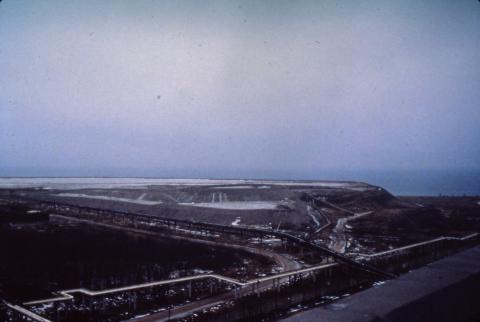
The tailings pond, with the Baltic Sea behind it.
Yellow cake production continued at the Silmet plant until the mid-eighties, when the nuclear arms race was being tamed by arms control agreements between the United States and Russia. The plant was converted to producing rare earth metals and oxides, as well as tantalum and niobium, used in steel, optical equipment, and electronics, including cell phones. The ore and concentrates came from Africa and the Karelian peninsula, just east of Finland. The tailings from this process included radioactive thorium and uranium. That brochure I received in 1992 was part of the newly privatized plant’s advertising.
The tailings continued to fill the space behind the dam. Water in them leaked through the soil below into the sea. Rain washed through the tailings, taking metals with it. Local drinking water was not contaminated only because it flowed toward the sea, away from water wells.
Occasionally alerts were issued prohibiting swimming or fishing in the sea around the plant. These frightened local people, who were prohibited from entering Sillamäe. Most likely those prohibitions came when the tailings overtopped the dam and flowed directly into the sea. The dam looked like it had been built in more than one increment.
_____
The weather was cold and sleety. The sidewalks were wet rather than slippery. The Lab allowed a day before the meeting to adjust to jet lag, so I used it to explore Old Town. The hotel had a rack of brochures and tourist magazines with maps. English, German, and two languages that I figured were Estonian and Finnish.
On the way to Old Town, an old woman was selling fruit. I picked up a couple of apples and, unfamiliar with Estonian money, held out some coins in my hand. She took a few small ones. A couple of parks on the way, then a brightly lit series of flower stalls and medieval towers.
An outdoor sweater market with Nordic-style sweaters. The store windows had a 1950s feel to them. Clothing styles were not what I was accustomed to, although I am not among the most stylish. Ancient Hansa commercial buildings with warehousing in the upper story and hooks from the roofs to haul materials up. Jewelry stores with amber, my favorite.
I stopped in one of the bookstores. Piles of books, shelves of books, mostly used. The Estonian shelf labels offered me few clues, but I found the history shelf, the nature shelf. Beautiful books on folk customs and attire. Then a music store with compact discs. Again, no way to read labels. Places to return to before I left.
_____
The meeting place for the Reference Group was within walking distance of the Olümpia. Jan Olof Snihs of the Swedish Radiation Protection Institute was the chair. Also included were members of the Estonian and Finnish Radiation Protection Institutes, representatives of nuclear energy related firms from Sweden and Germany, a Norwegian government geologist, a Russian representative from the Institute of Chemical Technology, which had run the Silmet plant, and Kaasik and Siinmaa. During the discussions, Snihs occasionally asked me “And what does the United States think?” I was taken aback, but made clear that my statements were not official.
Breaks allowed me to talk to other members. English was the working language; only the Russian representative had a whisper interpreter. The Estonians were still grappling with what a free economy would mean to them. A woman from the Ministry of the Environment said, “There were limits to how high you could go, but a safety net at the bottom.”
I learned more about Silmet and the nature of the problem. Samples had been taken in the tailings pond and the adjacent sea. It became clear that the industry reps hoped for contracts in the cleanup. There seemed to be some unease in the group about my presence. For the Estonians, the promise of a NATO workshop loomed large; membership in NATO promised protection from being resorbed into a reconstituted Soviet Union. For the others, a NATO workshop might subsume the work of the group.
The next day was a trip to Sillamäe. It was still dark and sleety. The two-hour bus drive took us past fairytale forests with white birches silhouetted against dark-blue spruces. Smoke curled up from the chimneys of cabins with steeply pitched roofs. The rivers near Sillamäe ran brownish, and my first thought was pollution. I later realized that the color was natural, from decayed leaves and peat bogs.
The tailings pond was immense. This was the “waste depository” that had puzzled us in 1992. Later, as I learned Estonian, I realized that the word they used for it, jäätmehoidla, could reasonably be translated that way. A pipe continued to add waste to the pile.

Pipe delivers waste to the tailings pond.
We toured the processing building, had a photo taken of the group on the roof. The Norwegian geologist proclaimed the breeze off the sea “fresh.” We toured the processing building and took pictures of the group on the roof.
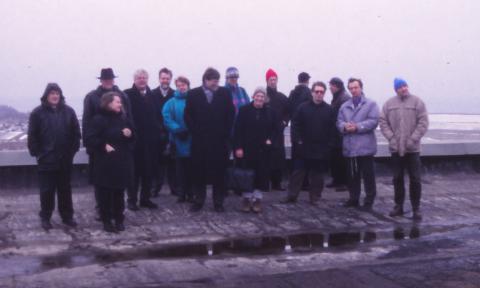
The members of the Sillamäe International Expert Reference Group on the roof of the Silmet processing building.
To enter the office building, we had to pass through a portal equipped with lights and dials. It looked like something out of a science fiction movie. I wondered if it was primarily for effect or if it was real. We were served coffee and tea by personnel very dressed up for the occasion. Later we had a formal lunch. I didn’t recognize the dishes, but they were good.
The whole site needed work. Piles of old equipment and piping had been randomly deposited. They would need to be monitored for radioactivity and removed. The shore line near the dam needed to be fortified against the waves with more four-foot boulders. The dam looked as if it had been built in stages, perhaps responding to overflows that had occasioned the coastal closures.
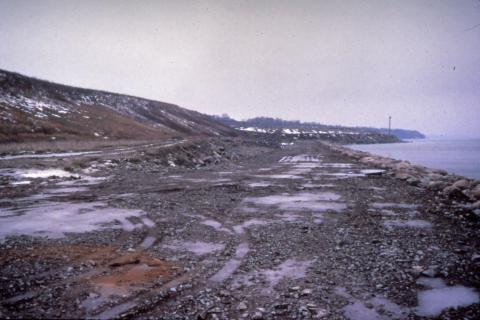
Tailings dam and shoreline.
There was no indication of uranium enrichment. The processing building was much smaller than what would be needed for enrichment. Nor were there the gloveboxes that would be needed for handling plutonium parts. Three giant reinforced-concrete shells of buildings stood on the land side of the site. Their function was not obvious and perhaps never will be known outside of the Russian Institute of Chemical Technology.
_____
On the last evening, I worked with Kaasik and Siinmaa, along with Mihkel Viederma, vice-chair of the Estonian Academy of Sciences, to develop a proposal to NATO for an Advanced Research Workshop on how the plant and tailings pond might be cleaned up. Viederma advocated the Estonian government view that industrial development must be part of the discussion, and we included that.
The area around Sillamäe also hosted oil-shale mining. Estonia has a very rich oil shale that can be burned like coal, but it produces a lot of ash. During Soviet times, Russian workers were brought in for oil-shale mining and for the Silmet plant. That part of Estonia, Ida-Virumaa county, has the highest percentage of ethnic Russians in Estonia. It is the part of Estonia that today causes worries about Russian unconventional warfare and “little green men”. In 1998, the Estonian government was well aware of the potential problem.
I brought the stack of flip-chart notes home and wrote a draft. We worked it over and submitted it in March. The proposal was successful, and our conference would be held in early October 1998.
My visit to Estonia in January intrigued me enough that I planned to come to the October conference a week early and drive around the country. As co-chair with Kaasik, I also decided that as part of my introductory remarks, I would say something in Estonian. Language had been an issue during the Soviet times; government efforts at forcing Russian as the sole language came and went. I wanted to show I respected Estonian concerns.
Estonian is related to Finnish and Hungarian, in the Finno-Ugric language family rather than the Indo-European family that English, Russian and all other European languages belong to. I bought a textbook and began learning. One of my colleagues at Los Alamos, Hain Oona, knew some Estonian and helped me, and Kaasik polished it. I would have a whole paragraph in my remarks, not just a token word or phrase.
As I took off across the country, I practiced saying the numbers for my rental car’s license plate. But my resolve broke down at the ferry to Muhu Island, and I silently handed over the rental car credentials to the ticket-seller. In Saaremaa, I found that the place I had reserved was for camping. I drove back into town and managed to secure a real hotel room, using a hash of Estonian, German, and numbers written on paper. A couple of nights in a classic Art Deco bed and breakfast in Viljandi were more successful, even with little common language.
At the conference, I warned the interpreters that I would shift to Estonian, in case my accent was bad enough that they couldn’t tell. But it went well, and most of the Estonian-speakers understood what I was saying and were pleased.
The conference included people who could evaluate whether the tailings were worth mining (they weren’t), people who had experience in remediating uranium mine tailings, and people who could help start thinking about how to end the emissions from the plant as processing continued. Another trip to Sillamäe, with journalists holding moppy microphones toward the bus. We were on Estonian and Finnish television that night.
We published a book of the proceedings. With that book, Kaasik solicited funds from the European Union and countries around the Baltic Sea. There was even some American aid for reengineering the plant so that it produced no uncontrolled emissions.
____
The remediation was completed in 2009. A wide and deep trench isolated the tailings pond from groundwater. The dam was stabilized with pilings that anchor into solid rock 70 meters below the Cambrian blue clay. Water was removed from the material behind the dam, much of the trash at the site went into the waste, and the area was covered with layers of oil shale ash, soil, sand, rubble from waste concrete at the site, and a layer of clay to shed water. Soil on top, with grass planted. When I was there in 2011, I saw brown hawks circling for rodents in the grass. These two photos, from 1998 and 2011, taken from the same location, look toward the processing building.
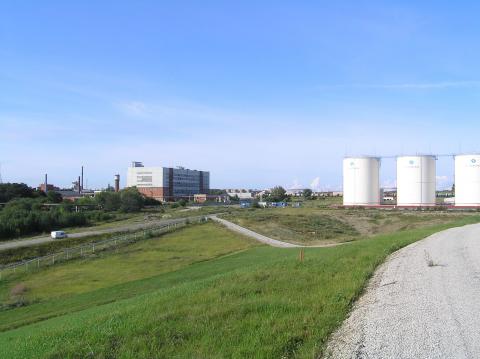
Looking toward the processing building from the waste area in 2011.
The Silmet plant still produces rare earths; it is one of the largest supplier of rare earths to the United States and was owned by the American company Molycorp until Molycorp’s bankruptcy reorganization. The plant is now a part of Neo Performance Materials. The Estonian government declared the industrial area of Sillamäe a tax-free zone to encourage industrial development. It includes a lead-recovery plant that receives automobile batteries for recycling from Finland, the Baltic States, Russia, and Israel.
A port was built at the outer reaches of the tailings pond. Tanks for chemical and petroleum storage are alongside the railroad that brings Russian petroleum to be shipped out and cars to be shipped to Russia. The port can handle any ship that can come through the Danish straits and has been expanded several times. A photo from 2011 shows it in beginning stages.
A large parking area accommodates trucks waiting to cross the border into Russia at Narva. A ferry for trucks operates between Sillamäe and Ust-Luga on the Russian side of the border to avoid the traffic jams at the bridge between Narva and Ivangorod.
The last photo looks at the plant from the beach near town. The large green mound is the remediated tailings pond.
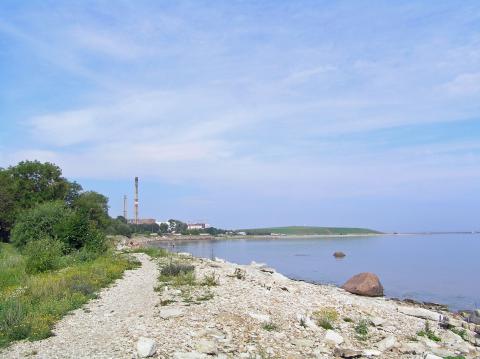
The plant from a beach near town. The green hill to the right is the remediated tailings pond.
I fell in love with Estonia that sleety dark January. I’ve been back many times, including to the song festivals. The story of how Estonia, along with Latvia and Lithuania, gradually moved toward regaining independence under Mikhail Gorbachev’s glasnost and perestroika is an impressive example of nonviolent resistance. The land is beautiful, and the history is fascinating. It’s very much a part of Europe now. I’m grateful that I could play a small part in its recovery.
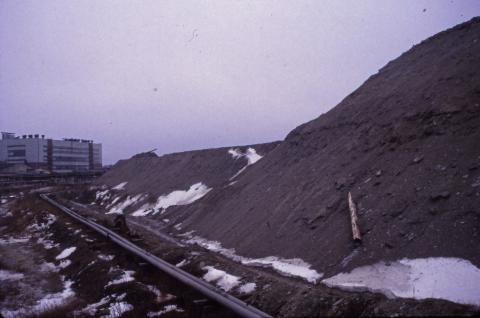
Looking toward the processing building from the waste area in 1998.
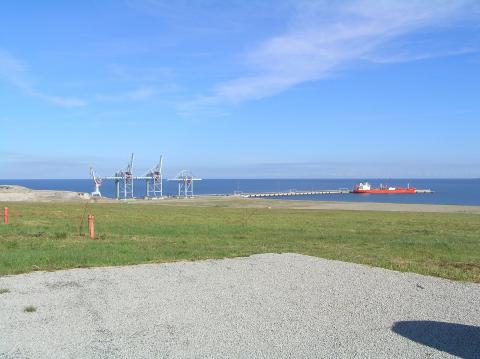
The port in 2011.
Read it in PDF
